Domestic analysts do not expect the Chinese central bank to engage in concerted action for the time being following the US Federal Reserve’s decision to slash rates to nearly zero in response to the impacts of the novel coronavirus.
On Sunday the US Federal Reserve cut its benchmark interest rate to almost zero as well as announced that it would purchase USD$700 billion in treasury and mortgage-backed securities, in a bid to keep the American economy on an even keel amidst the impacts of the Covid-19 crisis.
The following day on 16 March the People’s Bank of China (PBOC) undertook 100 billion yuan in one-year medium-term lending facility (MLF) operations with a rate of 3.15%, on par with the rate for the last MLF operation.
Domestic analysts speaking to PBOC’s official news outlet said that they do not expect further cuts in the near-term, given that the Chinese central bank took concerted action at an earlier stage of the crisis.
Everbright Securities fixed-income analyst Zhang Xu (张旭) said that China reduced its rates at the start of February, and that China’s monetary policy has always made a point of “prioritising China.”
These rates reductions included a 10 basis point cut for one-year medium-term lending facilities (MLF) to 3.15% on 17 February, and a 10 basis point cut for 7 day reverse repo rates to 2.4% on 3 February.
On 20 February the loan prime rate (LPR) also posted a decline, including a drop in the one-year rate of 10 basis points, and a decline in the five-year rate of five basis points.
Zhang said rates cuts were not as important as the implementation of the 300 billion yuan in specialist re-loans and 500 billion yuan in re-loan re-discounts unveiled by Beijing earlier, as well as hastening the extension of loans.
According to Zhang this will help to ensure supplies for combating the coronavirus in China, as well as the resumption of work and production by domestic enterprises.
Zhang further points out that reducing China’s MLF rates isn’t an urgent matter for the time being, given that Chinese capital markets have remained comparatively steady since the coronavirus hit.
In sharp contrast US stock markets posted sharp declines, compelling the Federal Reserve to adopt more vigorous rates cuts to maintain market confidence.
PBOC also implemented a targeted cut to the required reserve ratio (RRR) on 16 March, with an especial focus on China joint-stock banks.
The People’s Bank of China (PBOC) announced via its official website that banks that satisfy assessment standards will enjoy a targeted RRR cut of 0.5 to one percentage points, while qualified joint-stock banks will enjoy an additional targeted reduction of one percentage point, to support the issuance of financial inclusion loans.
It is estimated that the move will unleash long-term funds in the Chinese economy of 550 billion yuan.
Related stories


